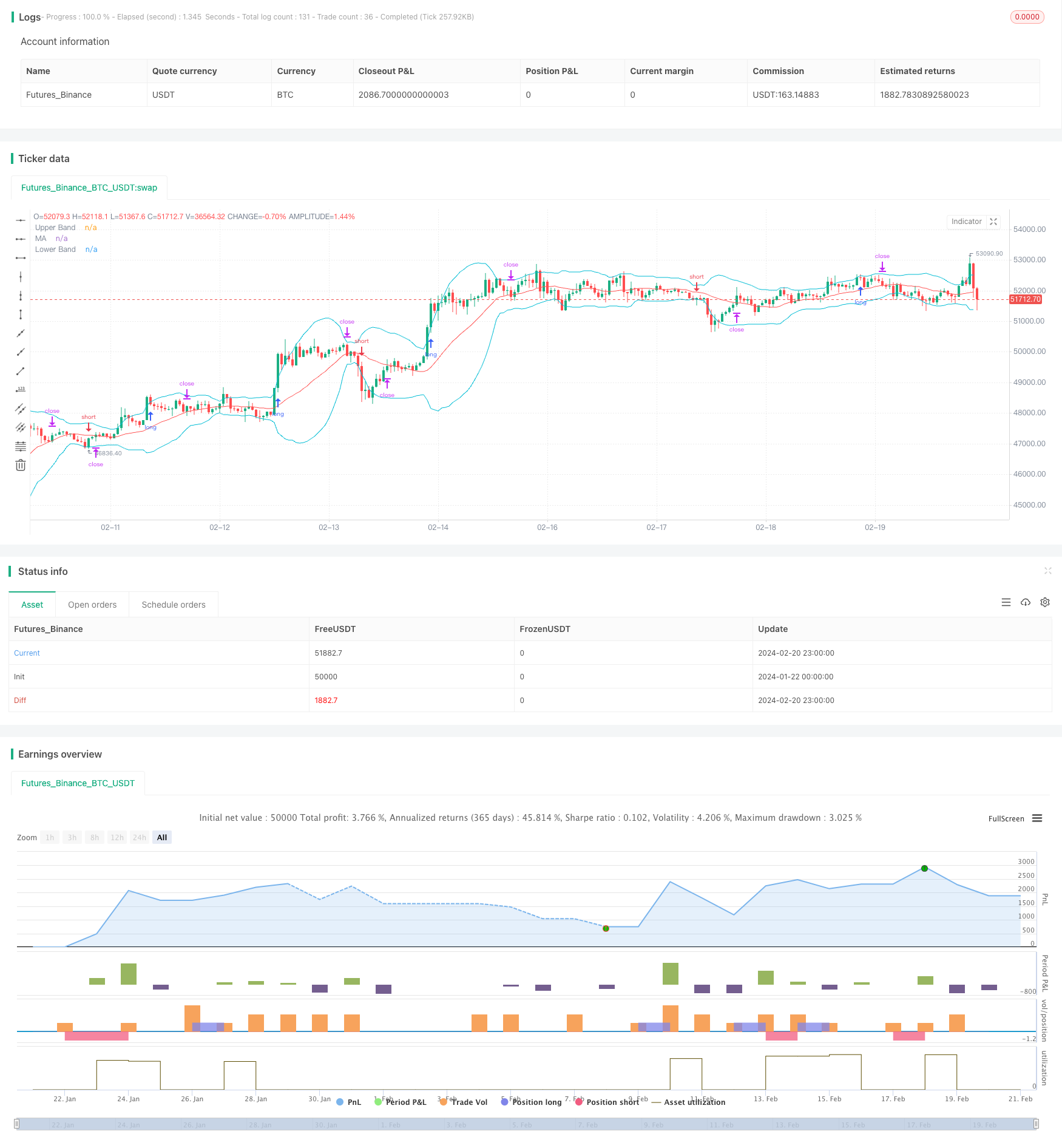
概述
该策略是一个基于布林带指标的趋势跟踪策略。它利用布林带上下轨来判断趋势方向,实现趋势追踪。当价格突破布林带上轨时做多,当价格跌破布林带下轨时做空,止损位则设置在布林带中间轨。
策略原理
该策略使用布林带指标判断价格趋势。布林带包含上轨、下轨和中间轨三条线。上轨线代表价格的上行极限,下轨线代表价格的下行极限,中间轨代表价格的移动平均线。当价格从下轨突破上轨时,表示开始上升趋势;当价格从上轨突破下轨时,表示开始下跌趋势。
具体来说,该策略判断长仓入场时,需要同时满足以下两个条件:1)当前K线收盘价高于布林带上轨;2)前一根K线的收盘价低于布林带上轨。这表示价格突破上轨,开始上升趋势,做多合适。判断短仓入场也是类似,当前K线收盘价低于布林带下轨并且前一根K线收盘价高于布林带下轨,表示做空时机成熟。
该策略的止损方式是:长仓止损位设置在布林带中间轨,短仓止损位也设置在中间轨。这是因为中间轨代表价格的移动平均线,是判断趋势是否改变的关键位置。
策略优势
该策略最大的优势在于能清晰判断价格趋势,利用布林带指标的特征实现趋势跟踪,避免被震荡市误导。相比其他指标,布林带对突破判断更加可靠,减少了假突破的概率。
另外,该策略同时设定了多空条件,可以双向交易,最大程度利用价格的上下波动获利。采用中轨作为止损位,可以提高止损精确性,及时止损离场是策略获利的关键。
策略风险
该策略主要的风险在于布林带的参数设定。布林带中轨时期和标准差大小,会直接影响上下轨的位置。如果参数设置不当,可能导致虚假突破的概率增加。
此外,中间轨作为止损位也存在风险。当行情出现较大波动时,价格可能直接跌破中间轨导致止损。这时就要评估大趋势是否发生转变,必要时可以适当扩大止损范围。
策略优化
该策略可以从以下几个方面进行优化:
优化布林带参数,结合不同周期积累经验数据,设定最佳参数组合。
增加成交量的判断指标,避免低量的假突破。可以设定成交量需超过近期平均值才能触发操作。
优化止损机制,可以根据市场波动度动态调整止损位。大幅波动时适当放宽止损范围,小幅波动时则缩紧止损追踪价格。
增加其他指标判断,如MACD、KDJ等,结合更多因素决定入场时机,提高操作准确性。
总结
本策略总体来说是一个较为实用的趋势跟踪策略。它利用布林带指标判断趋势方向,通过价格突破上下轨来发出操作信号,双向交易以最大限度捕捉价格波动。策略优化空间较大,通过参数优化、止损优化等手段可以获得更好的效果。
/*backtest
start: 2024-01-22 00:00:00
end: 2024-02-21 00:00:00
period: 1h
basePeriod: 15m
exchanges: [{"eid":"Futures_Binance","currency":"BTC_USDT"}]
*/
// © Valente_F
//@version=4
strategy(title="Strategy: Trend Following Bollinger Bands", shorttitle="Strategy: Trend Following Bollinger Bands", overlay = true, pyramiding = 0, default_qty_type = strategy.percent_of_equity)
//Inputs
//Bollinger Bands Parameters
length = input(defval=20, minval=1, title= "Length")
stddev = input(defval=2, minval=0.5, title= "StdDev")
// STRATEGY INPUTS
//Entry and Exit Parameters
checkbox1 = input(true, title="Enable Long Entrys")
checkbox2 = input(true, title="Enable Short Entrys")
//Bollinger Bands Calculation
[middle, upper, lower] = bb(close, length, stddev)
//Long Conditions
bulls1 = close > upper
bulls2 = close[1] < upper[1]
bulls = bulls1 and bulls2
//Short Conditions
bears1 = close < lower
bears2 = close[1] > lower[1]
bears = bears1 and bears2
// Plots of Bollinger Bands
plot(upper, title = "Upper Band", color = color.aqua)//, display = display.none)
plot(middle, title = "MA", color = color.red)//, display = display.none)
plot(lower, title = "Lower Band", color = color.aqua)//, display = display.none)
neutral_color = color.new(color.black, 100)
barcolors = bulls ? color.green : bears ? color.red : neutral_color
//Paint bars with the entry colors
barcolor(barcolors)
//Strategy
//STRATEGY LONG
long_entry = bulls and checkbox1
long_entry_level = high
strategy.entry("Long", true, stop = long_entry_level, when = long_entry)
strategy.cancel("Long", when = not long_entry)
strategy.exit("Stop Long", "Long", stop = middle)
//STRATEGY SHORT
short_entry = bears and checkbox2
short_entry_level = low
strategy.entry("Short", false, stop = short_entry_level, when = short_entry)
strategy.cancel("Short", when = not short_entry)
strategy.exit("Stop Short", "Short", stop = middle)